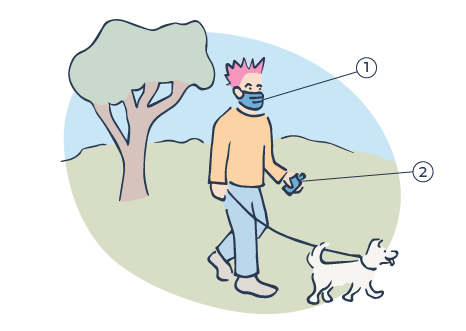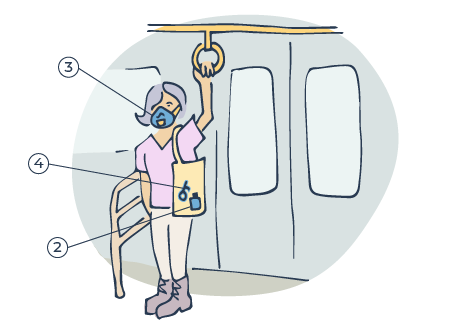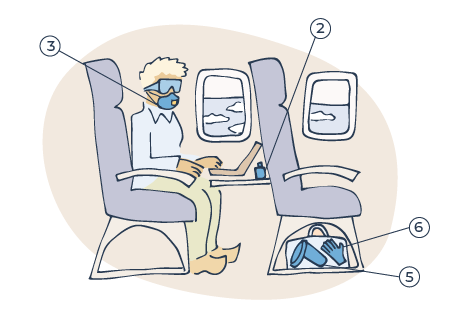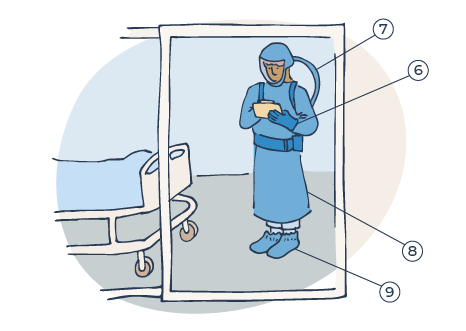Have you ever been confused about what PPE (protective personal equipment) will protect you and when you should wear it? OSMS has compiled research from twelve sources to give the public a comprehensive view of what kinds of PPE should be used to minimize the risk of COVID-19 infection during different types of activities.
How is COVID-19 spread?
COVID-19 spreads between people primarily through contact with infectious respiratory droplets which are released from the mouth or nose when an infected person coughs, sneezes, or speaks.[1] The virus will spread when these infectious droplets make contact with someone else’s mouth, nose, or eyes. Infection is most likely to occur when people are in close contact (within 6 feet) of an infectious person, especially in indoor environments with poor ventilation.[2] COVID-19 may also be spread by coming into contact with common, shared surfaces that have been contaminated by infectious respiratory droplets, like door handles, tabletops, elevator buttons, and pin pads, for example.[3] Additionally, the more time someone spends around an infected person, the higher their risk of acquiring COVID-19.

- Description: A piece of cloth with elastic ear loops or ties to firmly secure the cloth to your
face.
- Function: Primarily used to prevent your own respiratory droplets from infecting others.
- How to Use: Wear on your face and cover both your nose and mouth.
- When Used: Any time you leave the house, especially when going to shared indoor spaces.
- Look For: Surgical masks, cloth masks made of two layers of fabric, or cloth masks with a
disposable filter pocket. Ideally, masks include adjustable nose pieces that let you fit the mask to your
face.

- Description: A liquid, gel, or foam generally used to decrease infectious agents on your hands.
Washing your hands with soap and water is ideal, but hand sanitizer is useful on the go or in absence of
running water.
- Function: Used to prevent infection resulting from touching your face with contaminated hands.
- How to Use: Squeeze a dime-sized amount onto your palms and vigorously rub your hands, covering all
fingers and both the front and back of your hands.
- When Used: Any time you touch high-contact surfaces like gas pumps, door handles, shopping carts,
etc.
- Look For: Minimum 60% alcohol (ethanol) content. Do not use hand sanitizers made from methanol, as
this is toxic when absorbed through the skin.

- Description: A tool to open doors without exposing your hands to contaminated surfaces.
- Function: A hook grabs onto the handle of a door and helps open it; can also be used to push
buttons or move other items.
- How to Use: Keep a personal door handle opener tool and do not share it, wiping it down
occasionally with a disinfectant wipe.
- When Used: When you have to enter an actively-used building and touch a number of shared doors.
- Look For: Easily sanitized material, functionality to open different kinds of handles.

- Description: A sealed, tight-fitting face mask that uses material to filter out particles to
protect the wearer. This can include a cloth mask with a pocket for a filter, a rubber or 3D printed mask
with interchangeable filter elements, and conventional N95 masks. While an N95 is the most reliable and
efficient commercial product, stock and availability may be limited. Refer
to this article when choosing filter materials for non-commercial filter pocket masks.
- Function: Primarily used to protect the wearer from breathing in contaminated air and becoming
infected. Note that filtering masks with an exhaust valve do NOT protect others, may not be allowed under
mask rules designed to protect public health, and should be worn with an additional cloth covering over the
exhaust valve. Cloth covers underneath will not provide a proper seal to the face.
- How to Use: Wear on your face, tightly covering, fitting and sealing against both your nose and
mouth. If the mask uses ear loops, ear savers can help secure the mask loops to the back of your head while
preventing irritation.
- When Used: Should be used when interacting with people outside of your household for substantial
periods of time, or in public indoor spaces for substantial periods of time (greater than 15 minutes, per
CDC recommendations [9]).
- Look For: Closely sealed fit to face, replaceable filters if possible.

- Description: Sneeze guards and transparent partitions are a clear piece of material between you and
another human.
- Function: Use in addition to a face mask to protect yourself and others from droplets. Note that
they do not provide sufficient protection to not also need a face mask.
- How to Use: Set up between a person who has to remain in place, and others who move by that place.
Cut small holes if transfers between people are necessary, such as for money, tickets, or goods.
- When Used: Should be installed in situations in which someone is actively interacting with many
different people (checkout counter/register), or talking for long periods of time.
- Look For: Easily sanitized material, stable and secure mounting.

- Description: A clear, protective set of eye protection.
- Function: Used to protect the mucous membranes of your eyes from droplets, in addition to
preventing you from touching your eyes [12] [13]. May be used
instead of a Face Shield or Sneeze Guards / Transparent Partitions, or in addition to.
- How to Use: Wear securely on your head, ensuring a proper seal along the forehead and cheeks.
- When Used: Anytime you need to talk to others face-to-face for extended periods of time, or if you
have a difficult time not touching your eyes.
- Look For: Comfortable and complete face seal, scratch proof, easily sanitizable plastic.

- Description: Hand coverings made of thin disposable nitrile or latex.
- Function: Used to protect your hands while handling potentially contaminated surfaces and items for
extended periods of time.
- How to Use: Pull over your hands, covering your wrist. Do NOT touch your face, even if your hands
are gloved. After disposing of gloves, wash hands thoroughly with soap and water, or hand sanitizer if
necessary.
- When Used: Any time shared surfaces need to be touched on a regular basis, or when handling many
items from multiple people for extended periods of time. (i.e. cashier, servers, etc.)
- Look For: The correct size for your hands, no perforations or holes, a long wrist section for easy
removal.

- Description: N95 respirators are tight-fitting respirators that have been tested and commercially
certified for a specific level of protection from airborne particles.
- Function: Protect wearer by filtering out at least 95% of particles in the air, including large and
small particles.
- How to Use: Wear on your face, covering both your nose and mouth, ensuring a proper seal around
your entire mouth. An N95 respirator should be discarded after each patient encounter and after aerosol
generating procedures. It no longer offers adequate protection if it has been damaged, soiled ,
contaminated, or if breathing becomes difficult.
- When Used: When treating patients or when working in a hospital or healthcare facility where close
proximity to patients is required.
- Look For: Closely sealed fit to face, disposable.

- Description: PAPR stands for Powered Air Purifying Respirator and usually consists of a battery
operated fan, hood, filtering system (HEPA), and a half or full facepiece/hood.
- Function: Protect wearer by filtering all consumed air through a powered HEPA filter, which can
remove at least 99.97% of airborne particles.
- How to Use: Use a PAPR when an n95 is required but is unavailable or does not fit the wearer
properly, or when there is a high risk from aerosol generating procedures.
- When Used/Look For: Please refer to hospital-issued guidance if a PAPR is required.
![]()

- Description: Disposable or washable garments used by healthcare professionals together as part of
an infection barrier strategy.
- Function: Used to protect the wearer from the spread of infection or illness when in contact with
potentially contaminated liquids and solid material.
- When Used: During procedures and patient-care activities when anticipating contact with clothing,
blood, bodily fluids, secretions and excretions.
- How to Use/Look For: Please refer to hospital-issued or CDC guidance for up-to-date recommendations
on appropriate PPE [12]

- Description: A curved transparent shield that is worn on the head in front of your face.
- Function: Used in addition to a face mask to protect yourself, and others from respiratory droplets and splatter. When used effectively, reduces viral load on the face mask and increases reusability. Should not be worn without a face mask.
- How to Use: Wear securely with the shield portion covering your entire face, down past the bottom of your mask.
- When Used: Anytime you need to talk to others face-to-face for extended periods of time.
- Look For: Full face coverage to chin or lower, wide coverage temple-to-temple, comfortable forehead seal, easily sanitizable shield material.
What is PPE and why use it?
Personal protective equipment (PPE) is worn to protect the wearer from exposure to contaminants, and the term can refer to masks, respirators, face shields, gloves, goggles, gowns, and other equipment. Correct PPE use has the potential to block transmission of contaminants from bodily fluids (including respiratory droplets).[4] PPE should always be used alongside other infection control measures, such as hand-washing and the use of hand sanitizers, to reduce the spread of infection.[5] Effective use of PPE also includes knowing how to properly put on (donning) and take off (doffing) each item, and correctly disposing of these items to further reduce contact with contaminants.[6]
Different situations present different risks, and can require different kinds of PPE based on the time spent in certain environments, the type of environment, and the type of activity. Open Source Medical Supplies has compiled this guide on the proper use of PPE, given the risks of different kinds of situations, in order to help the public understand the role PPE has in preventing COVID-19 transmission in everyday situations.
PPE Used for Different Types of Risk
Examples of Risky Activities
Low Risk
- Opening the mail
- Getting restaurant takeout
- Pumping gasoline
- Playing tennis
- Going camping
- Going for a walk, run, or bike ride with others
- Playing golf
Moderate Risk
- Staying at a hotel for two nights
- Grocery Shopping
- Sitting in a doctor’s waiting room
- Going to a library or museum
- Eating in a restaurant (outside), or at someone’s house
- Walking in a busy downtown
- Spending an hour at a playground
High Risk
- Going to a hair salon
- Working in retail/cashier
- Eating in a restaurant (inside)
- Playing team sports
Higher Risk
- Traveling by plane
- Hugging or shaking hands when greeting a friend
- Working as a server
- Working out at a gym
- Going to an amusement park, movie theater, music concert
- Attending a religious service with 500+ worshippers
Clinical Risk
Treating Patients
- Treating COVID-19 Patients directly
- Checking in patients who are ill
- Talking with family and friends of patients who are ill
Treating ICU Patients
- Intubating Patients
- Treating ICU Patients
Source: Texas Medical Association Risk Assessment
Click on the Scenario to find out more about what kinds of PPE to use!
Low Risk: Walking Outside
Moderate Risk: Taking Public Transit
High Risk: Flying on an Airplane
Clinical Risk: Treating a Positive Patient
Low-Risk Activities:
Low Risk
[LowRisk]
Click on the numbers to learn more!
Large uncrowded rooms that are well- ventilated and socially-distant outdoor areas are relatively low risk. Low-risk activities include outdoor walks, hiking, exercising, and simple quick errands. These kinds of activities require minimal or no contact or conversations with others. It is still important to wear a cloth covering anytime you leave your house, even for a short while in order to protect others.
When you must remove your mask or return home after low-risk activities, remember to wash your hands or sanitize them immediately, before touching your face.
- Outdoors with proper social distancing, 6 feet apart.
- Minimal contact with other people for less than 15 minutes. [8][9]
- Minimal direct face-to-face conversation.
- Inside, in a large, well-ventilated area.
- Inside, in an enclosed location for short periods of time, with proper social distancing and mask wearing
Moderate Risk
[ModerateRisk]
Click on the numbers to learn more!
Spending hours in indoor areas (even if people are socially distant and wearing masks) and high-traffic/crowded outdoor areas are a moderate risk. Gatherings of groups, indoors or outdoors in socially-distant groups are also a moderate risk.
The most significant change to PPE one can make to minimize moderate risk is changing the type of face mask worn. While surgical masks and cloth face coverings protect other people if you are sick, they will not protect you from someone else’s respiratory droplets, even outdoors. It’s important to wear a close-fitting filtering mask, such as a cloth mask with a filter or a filtering mask like an N95, in order to effectively prevent infection.
Door handle openers and other personal tools can be used to reduce your frequency of touching common surfaces like handles. Remember to use hand sanitizer after taking off your PPE, and before touching your face.
- Inside a large, enclosed, well-ventilated location up to 45 min, with proper social distancing and with most people wearing masks (based on a study of hairdressers interacting with masked clients [10]).
- Around large groups of people wearing masks; check your state’s guidelines for acceptable group sizes
- Outdoors in small, socially-distant groups of people that are actively talking or shouting
- High-traffic areas where many people actively pass-through
High Risk
[HighRisk]
Click on the numbers to learn more!
Indoor areas with poor air circulation, and any crowded areas, are high risk even if masks are being worn. Tasks and activities that require regular and constant exposure to new people, or that feature extended contact with people where no social distancing is possible, are also high risk.
When engaging in high-risk activities, effective protection requires several layers of PPE. Filtering masks are still the most important element of PPE, but face shields, transparent partitions, and goggles can further prevent infection from respiratory droplets. Gloves are appropriate when touching contaminated surfaces regularly (like handling cash or using shared door handles), as long as you take care to properly remove gloves afterward and not touch your face while wearing them. You may want to use different elements of the PPE listed below, depending on the type of activity you are conducting.
Note that face shields and sneeze guards/transparent partitions may be used in addition to a filtering face mask, but are not sufficient to protect against infection and must always be used in addition to face masks. They are most effective when talking and interacting with a large number of people who may or may not be wearing masks. Face shields can be interchanged with sneeze guards/transparent partitions as the situation demands.
- Inside an enclosed location with poor ventilation, or for extended periods of time like a full workday, even with proper social distancing and mask-wearing.
- In large crowded groups of more than 20 people, whether indoors or outdoors, in which people are talking or shouting.
- Extremely high-traffic areas with regular exposure to new contacts for extended periods of time.
- Extended contact with people when no social distancing is possible, whether masked or not, indoors or out.
- Gatherings of larger than 250 people [11].
Clinical Risk
Hospitals and medical facilities all have individual and specific requirements and policies regarding appropriate use of PPE. The information provided aims to explain the full range of PPE used to limit exposure to COVID-19, but is in no means a recommendation. When traveling to a location where you are extremely likely to be in contact with someone COVID-19 positive, please first refer to the established institutional guidelines first.
- Working in a clinical setting where patients are treated.
- Several hours indoors with close contact with other people.
- Risk of direct exposure to patients infected with COVID-19.
- Potential extended exposure to contaminated surfaces.
Click on the numbers to learn more!
Additional PPE not shown:
Stay Safe
Read our other COVID-19 guides.



